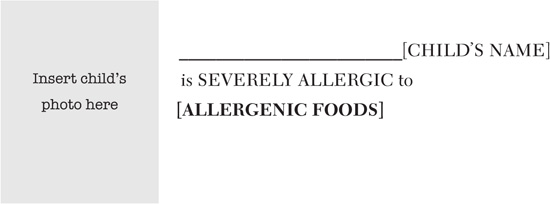
The information in this section is designed to help you in your everyday management of allergy. There are links for baking, shopping and education as well as some useful products that have been referred to throughout the book. There is a vast amount of support accessible through the internet and through charities. I would particularly recommend Allergy UK and the Anaphylaxis Campaign. Both of these are UK-based charities that provide product alerts, a newsletter, a fantastic website, training for families as well as healthcare professionals and support about living with allergies from childhood through to becoming a teenager. Allergy UK’s website can be found at www.allergyuk.org and their helpline number is 01322 619898. The Anaphylaxis Campaign website is www.anaphylaxis.org.uk. and the helpline number is 01252 542029.
‘Food allergy in children and young people’ (2011). National Institute for Health and Care Excellence – http://guidance.nice.org.uk/CG116
www.bda.uk.com/foodfacts/Allergy.pdf
‘Testing for Food Allergy in Children and Young People’ (2011). National Institute for Health and Care Excellence. Clinical Guidelines 116, 1–12.
www.breastfeedingnetwork.org.uk
Freddy the Mouse Allergy Education – www.freddythemouse.com
The BugyBops from the Buga Bees series – www.amazon.co.uk
The Itchy Kids Club by Jill Grabowski – www.amazon.co.uk
The No Biggie Bunch series – www.amazon.co.uk
One of the Gang by Gina Clowes – www.amazon.co.uk
Note: Medikidz produce a food allergy comic – www.medikidz.com
Allergen avoidance sheet – www.nice.org.uk
Food Standards Agency – www.food.gov.uk/safereating/allergyintol/label
www.bbc.co.uk/food/diets/gluten_free
www.bbc.co.uk/food/diets/nut_free
www.bbc.co.uk/food/diets/dairy_free
www.cozi.com/live-simply/lunch-box-envy-2
The Anaphylaxis Campaign website provides a list of possible triggers, top tips on how to conduct a risk assessment and set up a protocol to manage nut allergies in schools, including sample documents in the schools section of their website: www.anaphylaxis.org.uk
The Health Education Trust has developed a best practice guidance tool for ‘allergy aware’ training in secondary schools. This toolkit can be downloaded from www.healthedtrust.com/pdf/HET-allergy-toolkit.pdf The trust has produced a policy guide on ‘Managing Medicines in Schools’, which covers the issues surrounding pupils with food allergies along with asthma, epilepsy and diabetes, and it is available as a free download: www.gov.uk/government/publications/managing-medicines-in-schools-and-early-years-settings/
Get connected through Facebook and blogs. Below are some of the best support groups and websites. Please remember that these sites often reflect the views of their authors and should not take the place of a qualified professional.
www.actionagainstallergy.co.uk
Allergy UK – www.allergyuk.org
The American Academy of Allergy Asthma and Immunology – www.aaaai.org The Anaphylaxis Campaign – www.anaphylaxis.org.uk Food Standards Agency – www.food.gov.uk
www.bsaci.org – standard UK emergency plans
The following two emergency plans are examples only. Your child will need an individually tailored plan from a doctor. These ones are only for IgE mediated allergies (see here).

How to spot an allergic reaction:
What to do:
What to do if there are signs of anaphylaxis:
How to give an EpiPen.
• 1st contact: |
[MOST AVAILABLE PARENT/CARER NAME AND TELEPHONE NUMBER] |
• 2nd contact: |
[OTHER PARENT/CARER NAME AND TELEPHONE NUMBER] |
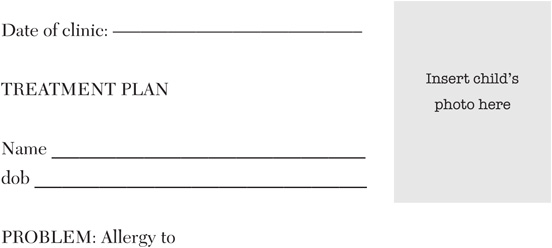
1. If he eats any of the above by mistake, he should immediately receive Piriton_mg (_× 5 ml teaspoon) [to be completed by child’s doctor] followed by 4 puffs of his Ventolin/Bricanyl via a spacer device.
2. If he develops breathing difficulties, noisy breathing, becomes blue, drowsy or unresponsive, he should be given the EpiPen syringe_mg [to be completed by child’s doctor] into the outer mid-thigh.
3. If breathing difficulties or EpiPen given, dial 999.
4. If he has not improved within 5–10 minutes, he should be given a second EpiPen and 10 puffs of his Ventolin.
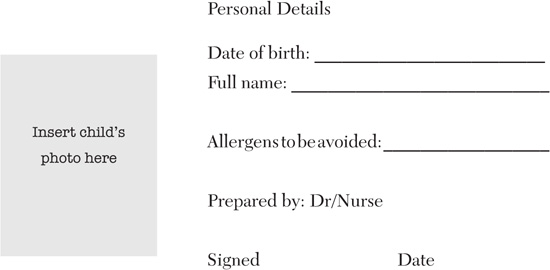
Additional information:
This person is at risk of a severe allergic reaction (anaphylaxis) if accidentally exposed to the trigger(s) that cause the allergic reaction.
Emergency medications should be accessible at all times while travelling.
Emergency medications may include one or more of the following: adrenaline autoinjectors (e.g. EpiPen or Jext), antihistamines, immunotherapy (either Staloral drops or Grazax tablets) and asthma medications, as per their Emergency Plan.
Administration of an adrenaline autoinjector is the first line treatment for anaphylaxis. Adrenaline autoinjectors contain a fixed, single dose of adrenaline and do not represent a safety risk.
A safe supply of food and liquids, appropriate for the travel period, should be permitted. The luggage hold of an aircraft is not an appropriate place for emergency medications to be stored as they:
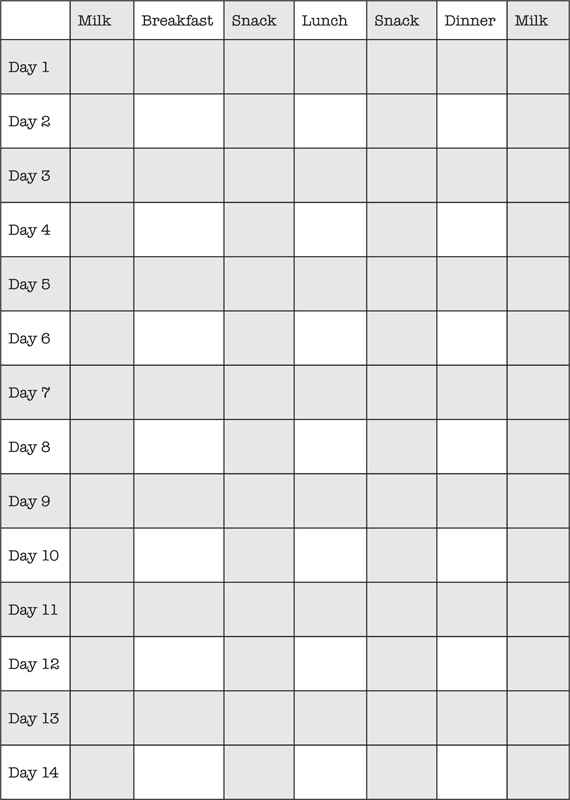
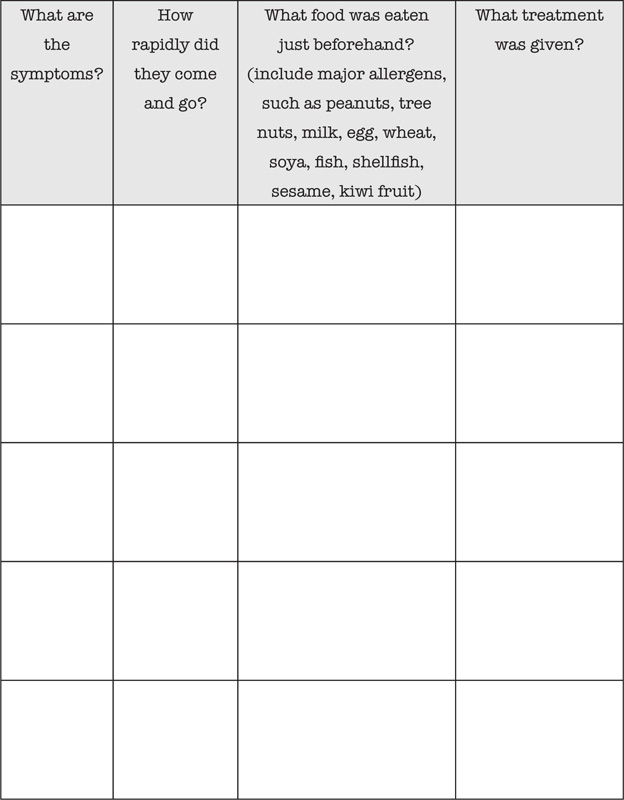
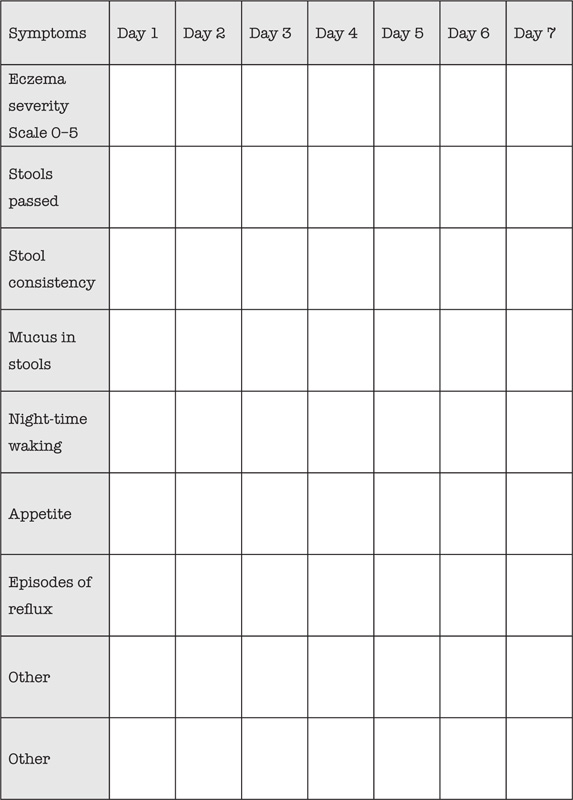
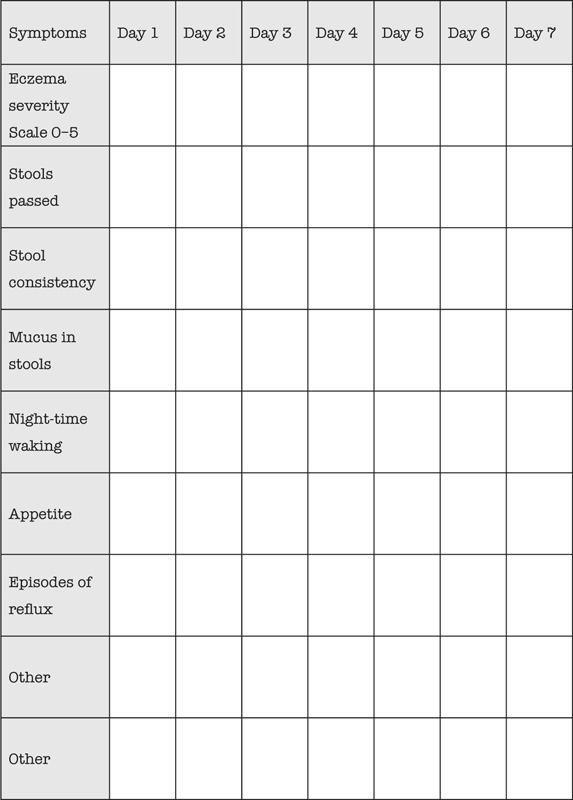
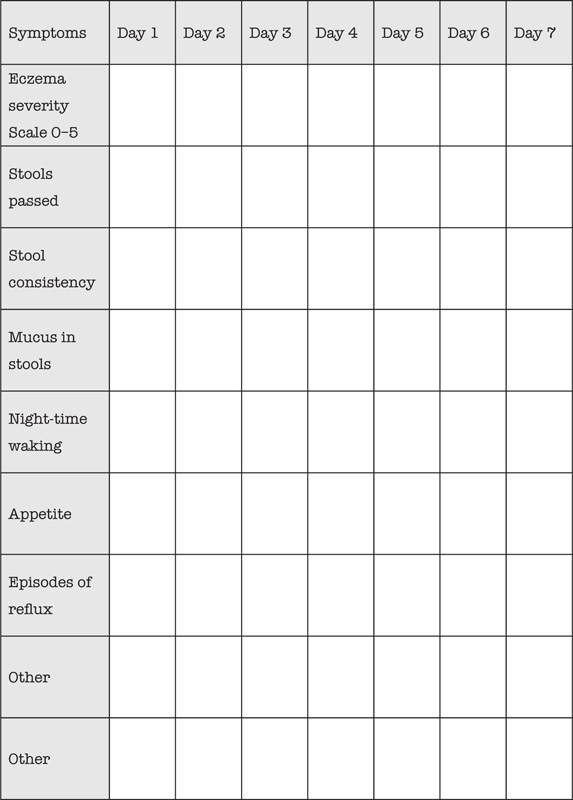
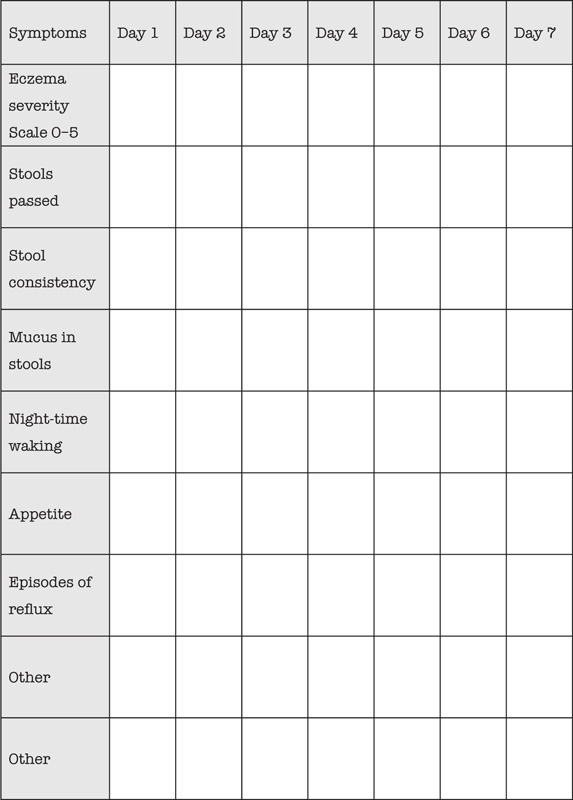
Below is a list of allergens and alternative names to look out for when reading labels. It also details the foods that commonly contain the allergens.*
Food name |
Also called |
Examples of foods that ‘may contain…’ |
Milk |
• Beta-lactoglobulin • Casein, rennet casein • Caseinate (ammonium caseinate, calcium caseinate, magnesium caseinate, potassium caseinate and sodium caseinate) • Delactosed or demineralised whey • Dry milk, milk solids • Hydrolysed casein and hydrolysed milk protein • Lactalbumin and lactalbumin phosphate • Lactose • Lactoferrin, lactoglobulin • Milk derivative, fat and protein • Modified milk ingredients • Whey and whey protein concentrate • Hydrolysed whey • Whey syrup sweetener |
• Butter, buttermilk • Cheese, curds • Cream, ice cream • Ghee and butter fat • Kefir (milk drink) • Kumiss (fermented milk drink) • Sour cream • Yoghurt |
Food name |
Also called |
Examples of foods that ‘may contain…’ |
• Albumin, albumen • Conalbumin • Egg substitutes, for example, Egg Beaters • Globulin • Livetin • Lysozyme • Ovo (means egg), for example, ovalbumin, ovomucin, ovotransferrin • Silico-albuminate • Vitellin • Dried egg • Lecithin (E322) (very rarely, usually soya based) • Ovoglobulin • Ovovitellin |
• Baked goods (including some type of breads) and baking mixes • Battered and fried foods • Cream-filled desserts, for example, custards, meringues, puddings and ice creams • Egg and fat substitutes • Fat replacers • Lecithin • Mayonnaise • Meat products with fillers, for example, meatballs and meatloaf • Nougats, marzipan • Pasta (fresh pasta, some types of dry pasta for example, egg noodles) • Quiche, soufflé • Salad dressings, creamy dressings • Sauces, for example, Béarnaise, hollandaise, Newburg, tartar |
Food name |
Also called |
Examples of foods that ‘may contain…’ |
• Arachis oil • Beer nuts • Goober nuts and goober peas • Ground nuts • Kernels • Mandelonas, Nu-Nuts • Nut meats • Valencias • Earth nuts • Manilla nuts • Monkey nuts • Pinda, pinder • Peanut flour/peanut protein |
• Ethnic foods, such as satay, Thai, Vietnamese, Chinese, Indian, Middle Eastern, African • Hydrolysed plant protein and vegetable protein • Nut substitutes • Peanut butter • Peanut oil • Vegetarian meat substitutes • Salad dressings • Biscuits, cakes, muesli bars • Breakfast cereals |
|
Fish |
|
• Surimi • Variations of Caesar salad with anchovies • Puttanesca sauce • Gentleman’s relish • Worcestershire sauce (contains anchovy) • Caponata • Kedgeree |
Food name |
Also called |
Examples of foods that ‘may contain…’ |
• Anacardium nuts • Filberts (hazelnuts) • Nut meats • Pinon • Queensland nut (macadamia) |
• Dishes such as almond chicken, pad thai and satay • Gianduja and gianduia • Marzipan (almond paste) • Tree nut oils • Pralines • Spreads, for example, almond paste-based spreads, cheese spreads, chocolate nut spreads • Nougat • Nut butter • Nutella • Vegetarian dishes • Processed meat products e.g. coronation chicken • Pesto • Chocolates, biscuits, etc. |
Food name |
Also called |
Examples of foods that ‘may contain…’ |
• Bean curd, soybean curds • Edamame • Kinako • Natto • Nimame • Okara • Soya, soja, soybean and soyabeans • Soy protein, vegetable protein, soya nuts • Textured soy flour (TSF), textured soy protein (TSP) and textured vegetable protein (TVP) • Yuba • Soya albumin • Lecithin (E322)/soya lecithin • Miso • Soya protein isolate • Tofu • Hydrolysed vegetable protein |
• Bean sprouts • Breadcrumbs, cereals and crackers • Breaded foods • Hydrolysed plant protein (HPP), hydrolysed soy protein (HSP) and hydrolysed vegetable protein (HVP) • Imitation dairy food • Child formula, follow-up formula, nutrition supplements for toddlers and children • Meal replacements • Meat products with fillers • Mexican foods, for example, chilli, taco fillings and tamales • Miso • Nutrition supplements • Sauces, for example, soy, shoyu, tamari, teriyaki, Worcestershire • Simulated fish and meat products • Stews • Tempeh • Vegetarian dishes |
Food name |
Also called |
Examples of foods that ‘may contain…’ |
• Durum wheat, spelt, Kamut • Couscous • Bran, wheat bran, wheatgerm, wheat gluten • Farina • Rusk • Semolina, durum wheat semolina • Flour, wholewheat flour, wheat flour, wheat starch • Starch, modified starch, hydrolysed starch, food starch, edible starch • Vegetable starch, vegetable gum, vegetable protein • Cereal filler, cereal binder, cereal protein • All cereals of Tiiticum genus • Tiiticum spelta L. (spelt) • Triticum poloniwum L.C (Polish wheat) • Triticum turgidum (Kamut) |
• Bread and baked foods: many rye and corn loaves contain some wheat. Pitta, crumpets, muffins, tortillas, tacos, doughnuts, cakes, cookies, biscuits, crackers, croutons, packet snacks, rusks, waffles, pancakes, crepes, pizzas, pretzels, breadsticks, communion wafers, pasta and pastry. Also Yorkshire pudding, suet pudding and many other puddings • Cereals: most cereals will contain some wheat. The exceptions are porridge oats, corn flakes, rice krispies and granola. Always read the labels • Flour and pasta: all of these will contain some wheat unless stated to be wheat free or buckwheat, which is not from the wheat family • Meat and fish: burgers, rissoles, salami, sausages, corned beef, luncheon meat, liver-sausage, continental sausages, pâtés, meat and fish pastes and spreads, ham, fish and Scotch eggs and other breaded meats and poultry |
Food name |
Also called |
Examples of foods that ‘may contain…’ |
|
• Vegetable products: vegetable pâtés and spreads, vegetables coated in breadcrumbs, vegetables tempura, tinned beans, soups and tinned and packet snack or ready-prepared foods • Sauces and condiments: gravy, packet, jar and bottled sauces, casserole and ready-meal mixes, stock cubes and granules, ready-prepared mustard, stuffing, baking powder, monosodium glutamate, some spice mixes • Desserts: most puddings, pastry, yoghurts containing cereal, ice cream, pancakes, cheesecakes and others with a biscuit base • Beverages: malted milk, chocolate, Ovaltine and other powdered drinks • Sweets: liquorice, chocolate, chocolate bars and most wrapped bars. Other sweets (check labels) • Medication: many prescribed and over-the-counter drugs contain wheat • Other: glue on labels and postage stamps |
Food name |
Also called |
Examples of foods that ‘may contain…’ |
• Benne, benne seed and benniseed • Gingelly and gingelly oil • Seeds • Sesamol and sesamolina • Sesamum indicum • Simsim • Til |
• Bread, breadcrumbs and sticks, cereals, crackers, melba toast and muesli • Dips and spreads • Ethnic foods, for example, flavoured rice, noodles, shish kebabs, stews and stir fries • Sesame oil, sesame salt (gomasio) • Tahini (sesame paste) • Tempeh • Vegetarian burgers |
Food name |
Also called |
Examples of foods that ‘may contain…’ |
• Clams • Mussels • Scallops • Oysters • Winkles • Some crustaceans commonly eaten are shrimp, prawn, lobster, crayfish and crabs |
• Ceviche • Cioppino • Callaloo • Clam chowder • Curanto • Fruits de mer • Paella • Sashimi • Shrimp cocktail • Lobster bisque • She-crab soup • Sliced fish soup • Sushi Check the following: • Caponata (Sicilian relish) • Gelatin if derived from fish bones • Marshmallows depending on gelatin used • Pizza toppings • Salad dressings • Sauces • Spreads • Deli meats • Hot dogs (from gelatin) • Compost or fertilisers • Lip balm and gloss • Pet food |
* Lists adapted from www.kidswithfoodallergies.org